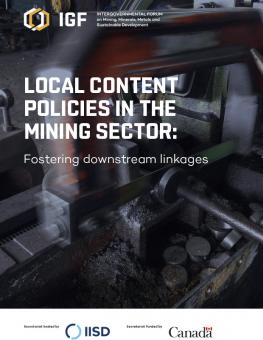
Local Content Policies in the Mining Sector: Fostering downstream linkages
The paper, focused on downstream linkages, is part of a set of expert documents to substantiate the IGF Guidance for Governments on local content policies, released in July 2018.
There is a strong belief in many resource-rich developing countries that in order to achieve industrial development raw materials should be processed domestically rather than being exported in their unprocessed form.
Driven by this objective of fostering industrialization, some governments have undertaken measures to either prescribe or incentivize downstream beneficiation.
This paper summarizes key policy options generally adopted by governments to encourage downstream activities, pointing to the strengths and weaknesses of each type of policy. These include various forms of fiscal and non-fiscal incentives; prescriptive measures such as export duties; bans or legal obligations to engage in beneficiation; the use of bargaining power in negotiations; beneficiation conditions linked to bidding processes; and government-led investments. The paper concludes with policy recommendations.
The discussion is built on a selection of geographically and economically diverse case studies and several commodities, namely copper, diamonds, iron ore, nickel and oil. Five of the case studies—Australia, Botswana, Nigeria, Indonesia and Singapore—have been published as stand-alone notes on the IGF local content guidance webpage. The paper is part of a set of expert documents to substantiate the IGF Guidance for Governments on local content policies, released in July 2018.
You might also be interested in
Artisanal and Small-Scale Mining of Critical Minerals
This report examines the potential for artisanal and small-scale mining (ASM) to take an expanded role in the global supply of critical minerals.
Leveraging Digital Infrastructure for Mining Community Resilience
This report explores the socio-economic impacts and potential of new technologies in the mining sector.
Navigating Global Sustainability Standards in the Mining Sector
This brief examines the latest developments and trends in responsible mining standards and voluntary sustainability initiatives.
IISD Annual Report 2023–2024
While IISD's reputation as a convenor, a trusted thought leader, and a go-to source on key issues within the sustainable development field is stronger than ever, the work happening outside the spotlight is just as valuable.